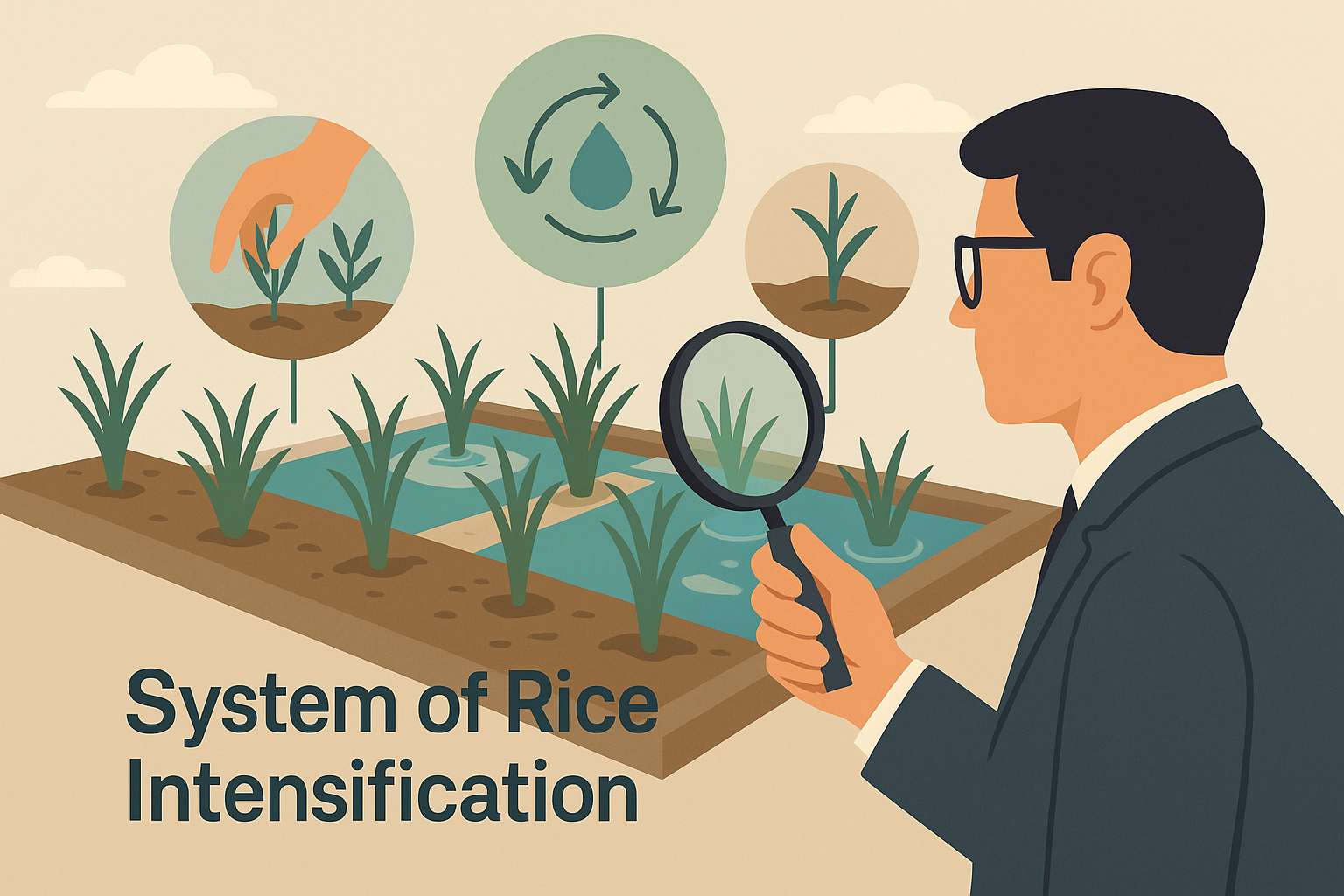Expert’s Eye View: SRI (System of Rice Intensification
The Statesman

1. Introduction and Context
This article presents an interview-based examination of the System of Rice Intensification (SRI) — a climate-smart, agro-ecological method of rice cultivation that promises higher yields, lower water usage, reduced inputs, and improved soil health.
The expert interviewed evaluates:
- SRI’s performance across Indian states
- Existing adoption gaps
- Institutional and behavioural constraints
- Policy and system-level changes needed to mainstream SRI
The discussion directly links to key UPSC themes such as sustainable agriculture, water management, food security, climate resilience, rural livelihoods, and agricultural reforms.
2. Key Arguments Presented
a. SRI increases yields while reducing inputs
The expert highlights compelling advantages:
- 30–50% water savings
- 70–80% reduction in seed requirement
- Higher yields (20–50%) compared to conventional paddy
- Reduced fertilizer use
- Improved soil health
- Lower methane emissions
Thus, SRI is presented as a farmer-friendly and climate-smart innovation, essential for water-scarce regions.
b. Adoption across India remains uneven
Despite its proven benefits, SRI uptake is slow due to:
- Farmer risk aversion and reluctance to change habits
- Lack of field demonstrations
- Labour shortages during early transplanting stages
- Weak extension systems
- Limited institutional push
- Poor access to weeders and tools
Adoption has been piecemeal, not systemic.
c. Bihar is India’s most successful SRI model
Bihar’s success stems from:
- Strong government programs
- Extensive demonstrations and training
- Integration with women’s Self-Help Groups (SHGs)
- Convergence with livelihood missions
- Incentivising SRI through local structures
However, sustainability depends on continued training, handholding, and monitoring.
d. Persistent implementation challenges
Farmers require:
- Precision in spacing seedlings
- Training in young seedling handling
- Timely availability of weeders
- Labour during early stages
- Knowledge on nursery raising
- Climate-suitable transplanting windows
Even minor deviation reduces yields, making capacity-building critical.
e. SRI can scale only with institutional support
The expert calls for:
- Mainstreaming SRI in agricultural university curricula
- Strong extension networks (KVKs, ATMA, SHGs)
- MSP and procurement policies aligned with SRI
- Integration with national schemes on water, soil, climate, and productivity
With systemic support, SRI can transition from an “alternative method” to a mainstream national strategy.
3. Author’s Stance
The stance is strongly pro-SRI:
- Advocates SRI as scientifically robust and climate-resilient
- Criticises sluggish government and institutional adoption
- Encourages large-scale training and field-level handholding
However, the tone remains realistic, acknowledging behavioural barriers, skill requirements, and logistical constraints.
4. Bias and Limitations
Bias
- Strong bias in favour of SRI; competing innovations like DSR, precision farming, micro-irrigation, hybrid seeds are not discussed.
- Assumes SRI superiority across all agro-climatic conditions.
Limitations
- No rigorous cost-benefit comparison with alternative rice cultivation methods.
- Does not analyse farmer reluctance from socio-cultural perspectives.
- Oversimplifies supply-chain issues such as MSP distortions.
- Does not address state-wise ecological variations or soil differences.
5. Pros and Cons of SRI (as presented)
Pros
- 30–50% water savings
- 20–50% yield increase
- 70–80% seed savings
- Lower methane emissions
- Compatible with organic farming
- Higher profitability
Cons
- Labour-intensive in early stages
- Precision and skill required
- Not ideal for all soils or climates
- Farmer resistance due to risk and habit
- Mechanisation compatibility still limited
- Needs continuous training and handholding
6. Policy Implications
a. Integrate SRI into National Missions
- PMKSY (micro-irrigation and water-use efficiency)
- PKVY (organic farming)
- NFSM (rice productivity)
- National Mission on Sustainable Agriculture
SRI aligns with national goals on water conservation and sustainability.
b. Strengthen Extension Systems
- Expand KVK outreach
- Train agri-workers at panchayat level
- Promote SHG-led community farming
- Ensure continuous farmer handholding
c. Incentivise Sustainable Rice Farming
- MSP bonuses or differential MSP for SRI paddy
- Subsidies for mechanical weeders
- Convergence with MGNREGA for labour-intensive tasks
d. Promote Climate-Resilient Agriculture
SRI is vital for:
- Drought-prone and groundwater-stressed regions
- Areas with high fertilizer costs
- Areas affected by erratic monsoons
e. Region-Specific Research
Agricultural universities must:
- Conduct multi-zone evaluation
- Develop mechanised SRI variants
- Integrate SRI with new rice varieties
7. Alignment with UPSC GS Papers
GS Paper I
- Agriculture in rural India
- Climate impact on traditional livelihoods
GS Paper II
- Government policies for farmers
- Role of institutions like KVKs, SHGs
GS Paper III
- Sustainable agriculture
- Water-use efficiency
- Climate-resilient cropping
- Food security challenges
Essay Paper
Relevant to essays on:
- Sustainable agriculture
- Climate-resilient farming
- Farmer-centric reforms
8. Real-World Impact
If SRI scales effectively:
- Massive water savings in rice cultivation
- Higher farmer incomes
- Lower methane emissions (climate benefit)
- Strengthened food security
- Low-cost, sustainable agricultural growth
If poorly implemented:
- Farmers abandon SRI after poor initial results
- Policy credibility weakens
- Productivity stagnates in vulnerable districts
Thus, institutional handholding is essential.
9. Conclusion and Future Perspectives
The article provides a practical and grounded analysis of India’s SRI journey. It argues convincingly that SRI represents a transformative, climate-resilient, and farmer-friendly innovation suitable for India’s water-scarce and input-cost-heavy agriculture.
However, successful scaling needs:
- Strong extension services
- Continuous farmer training
- Policy alignment (MSP, schemes, procurement)
- Scientific validation
- Mechanisation support
- Institutional flexibility
The future lies in SRI + mechanisation + climate resilience + region-specific adaptation, ensuring sustainable agriculture becomes the mainstream, not the exception
